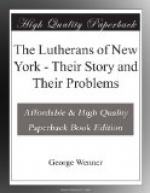In 1871 the divergent fragments of the German people, after many futile experiments in their history, at last attained national unity. The Germans of New York celebrated the event with a procession which made a deep impression upon the city. From that day forward they were no longer held below par in popular estimation. This became manifest in the success of their efforts in the field of social and religious work. Thirty German churches were added to the roll before the close of the century.
The completion of the Elevated Lines in 1879 and the Brooklyn Bridge in 1883 changed the course of history for our Lutheran congregations. For decades the ever-increasing hosts of immigrants had been interned in unwholesome tenements on a narrow island. Now ways of escape were found. Wide thoroughfares led in every direction. The churches in Brooklyn and Bronx grew rapidly in numbers and in strength.
It was hard for those of us who still held the fort on Manhattan Island to see the congregations we had gathered with painstaking effort scattering in every direction, especially to lose the children and the grandchildren of our faithful families. But when we saw them in the comfortable homes and open spaces of the suburbs, who could wish them to return to the hopeless atmosphere of the tenements? From this time forward the churches of the surrounding boroughs grew rapidly, largely at the expense, however, of the churches of Manhattan.
From 1881 to the close of the century Bronx added nine churches, Richmond five, Brooklyn and Queens thirty-two to the roll. Manhattan, it is true, also added eleven churches, but they were all above Forty-second Street, most of them far uptown.
The tenth of November, 1883, was a red letter day in our calendar. It was the quadricentennial of Luther’s birthday. The preparations for the celebration met with a hearty response in the city. The large dailies gave much space to the occasion. Dr. Seiss delivered a memorable address in Steinway Hall. Under the auspices of the Evangelical Alliance a distinguished company gathered in the Academy of Music and heard William Taylor and Phillips Brooks deliver orations of majestic eloquence.
The celebration gave a marked impulse to our church work. Our congregations increased in numbers and in influence. Its chief value was in its efeet [sic] upon the young people. Hitherto they hardly comprehended the significance of their church. Its services were conducted in a language which they understood with difficulty. As they grew up and established new homes in the suburbs where there were few churches of their faith, they easily drifted out of their communion. A great change came over them at this time. They began to take an active interest in church questions and in church extension. As they followed the inevitable trend to the suburbs they connected themselves with churches of their faith or organized new ones and became active workers in them. The remarkable increase of congregations in the entire Metropolitan District was to a large extent owing to the impulse derived from the quadricentennial of 1883.




